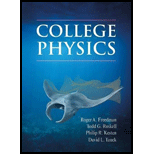
COLLEGE PHYSICS
2nd Edition
ISBN: 9781464196393
Author: Freedman
Publisher: MAC HIGHER
expand_more
expand_more
format_list_bulleted
Concept explainers
Question
Chapter 1, Problem 1QAP
To determine
The definition of basic quantities in physics like length, mass and time along with the SI unit that is used for each quantity.
Expert Solution & Answer
Explanation of Solution
Length is the scalar quantity representing the dimension. It is the distance between two points. Its SI unit is meter.
Mass is the physical property due to which an object provide resistance to acceleration when enacted by an external force. Its SI unit is Kilogram.
Time is the period during which an action continues, exists or proceeds. Its SI unit is seconds.
Want to see more full solutions like this?
Subscribe now to access step-by-step solutions to millions of textbook problems written by subject matter experts!
Students have asked these similar questions
A capacitor with a capacitance of C = 5.95×10−5 F is charged by connecting it to a 12.5 −V battery. The capacitor is then disconnected from the battery and connected across an inductor with an inductance of L = 1.55 H . At the time 2.35×10−2 s after the connection to the inductor is made, what is the current in the inductor? At that time, how much electrical energy is stored in the inductor?
Can someone help me with this question. Thanks.
Can someone help me with this question. Thanks.
Chapter 1 Solutions
COLLEGE PHYSICS
Ch. 1 - Prob. 1QAPCh. 1 - Prob. 2QAPCh. 1 - Prob. 3QAPCh. 1 - Prob. 4QAPCh. 1 - Prob. 5QAPCh. 1 - Prob. 6QAPCh. 1 - Prob. 7QAPCh. 1 - Prob. 8QAPCh. 1 - Prob. 9QAPCh. 1 - Prob. 10QAP
Ch. 1 - Prob. 11QAPCh. 1 - Prob. 12QAPCh. 1 - Prob. 13QAPCh. 1 - Prob. 14QAPCh. 1 - Prob. 15QAPCh. 1 - Prob. 16QAPCh. 1 - Prob. 17QAPCh. 1 - Prob. 18QAPCh. 1 - Prob. 19QAPCh. 1 - Prob. 20QAPCh. 1 - Prob. 21QAPCh. 1 - Prob. 22QAPCh. 1 - Prob. 23QAPCh. 1 - Prob. 24QAPCh. 1 - Prob. 25QAPCh. 1 - Prob. 26QAPCh. 1 - Prob. 27QAPCh. 1 - Prob. 28QAPCh. 1 - Prob. 29QAPCh. 1 - Prob. 30QAPCh. 1 - Prob. 31QAPCh. 1 - Prob. 32QAPCh. 1 - Prob. 33QAPCh. 1 - Prob. 34QAPCh. 1 - Prob. 35QAPCh. 1 - Prob. 36QAPCh. 1 - Prob. 37QAPCh. 1 - Prob. 38QAPCh. 1 - Prob. 39QAPCh. 1 - Prob. 40QAPCh. 1 - Prob. 41QAPCh. 1 - Prob. 42QAPCh. 1 - Prob. 43QAPCh. 1 - Prob. 44QAPCh. 1 - Prob. 45QAPCh. 1 - Prob. 46QAPCh. 1 - Prob. 47QAPCh. 1 - Prob. 48QAPCh. 1 - Prob. 49QAPCh. 1 - Prob. 50QAPCh. 1 - Prob. 51QAPCh. 1 - Prob. 52QAPCh. 1 - Prob. 53QAPCh. 1 - Prob. 54QAPCh. 1 - Prob. 55QAP
Knowledge Booster
Learn more about
Need a deep-dive on the concept behind this application? Look no further. Learn more about this topic, physics and related others by exploring similar questions and additional content below.Similar questions
- Can someone help me with this question. Thanks.arrow_forwardIdentical rays of light enter three transparent blocks composed of different materials. Light slows down upon entering the blocks.arrow_forwardFor single-slit diffraction, calculate the first three values of (the total phase difference between rays from each edge of the slit) that produce subsidiary maxima by a) using the phasor model, b) setting dr = 0, where I is given by, I = Io (sin (10) ². 2arrow_forward
arrow_back_ios
SEE MORE QUESTIONS
arrow_forward_ios
Recommended textbooks for you
 Physics for Scientists and Engineers: Foundations...PhysicsISBN:9781133939146Author:Katz, Debora M.Publisher:Cengage Learning
Physics for Scientists and Engineers: Foundations...PhysicsISBN:9781133939146Author:Katz, Debora M.Publisher:Cengage Learning College PhysicsPhysicsISBN:9781938168000Author:Paul Peter Urone, Roger HinrichsPublisher:OpenStax College
College PhysicsPhysicsISBN:9781938168000Author:Paul Peter Urone, Roger HinrichsPublisher:OpenStax College University Physics Volume 1PhysicsISBN:9781938168277Author:William Moebs, Samuel J. Ling, Jeff SannyPublisher:OpenStax - Rice University
University Physics Volume 1PhysicsISBN:9781938168277Author:William Moebs, Samuel J. Ling, Jeff SannyPublisher:OpenStax - Rice University Principles of Physics: A Calculus-Based TextPhysicsISBN:9781133104261Author:Raymond A. Serway, John W. JewettPublisher:Cengage Learning
Principles of Physics: A Calculus-Based TextPhysicsISBN:9781133104261Author:Raymond A. Serway, John W. JewettPublisher:Cengage Learning An Introduction to Physical SciencePhysicsISBN:9781305079137Author:James Shipman, Jerry D. Wilson, Charles A. Higgins, Omar TorresPublisher:Cengage Learning
An Introduction to Physical SciencePhysicsISBN:9781305079137Author:James Shipman, Jerry D. Wilson, Charles A. Higgins, Omar TorresPublisher:Cengage Learning Physics for Scientists and Engineers, Technology ...PhysicsISBN:9781305116399Author:Raymond A. Serway, John W. JewettPublisher:Cengage Learning
Physics for Scientists and Engineers, Technology ...PhysicsISBN:9781305116399Author:Raymond A. Serway, John W. JewettPublisher:Cengage Learning

Physics for Scientists and Engineers: Foundations...
Physics
ISBN:9781133939146
Author:Katz, Debora M.
Publisher:Cengage Learning

College Physics
Physics
ISBN:9781938168000
Author:Paul Peter Urone, Roger Hinrichs
Publisher:OpenStax College

University Physics Volume 1
Physics
ISBN:9781938168277
Author:William Moebs, Samuel J. Ling, Jeff Sanny
Publisher:OpenStax - Rice University

Principles of Physics: A Calculus-Based Text
Physics
ISBN:9781133104261
Author:Raymond A. Serway, John W. Jewett
Publisher:Cengage Learning

An Introduction to Physical Science
Physics
ISBN:9781305079137
Author:James Shipman, Jerry D. Wilson, Charles A. Higgins, Omar Torres
Publisher:Cengage Learning

Physics for Scientists and Engineers, Technology ...
Physics
ISBN:9781305116399
Author:Raymond A. Serway, John W. Jewett
Publisher:Cengage Learning
Math Antics - Scientific Notation; Author: mathantics;https://www.youtube.com/watch?v=bXkewQ7WEdI;License: Standard YouTube License, CC-BY
Physics CH 0: General Introduction (14 of 20) How to Estimate Number of Teachers in US; Author: Michel van Biezen;https://www.youtube.com/watch?v=GBv_JLUzM-M;License: Standard Youtube License